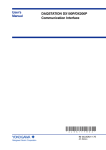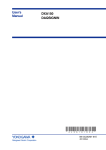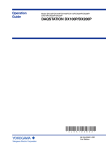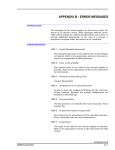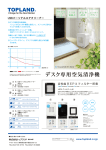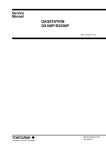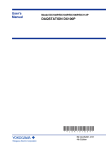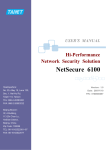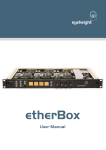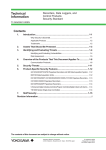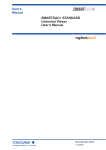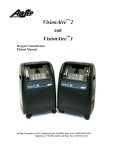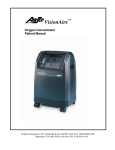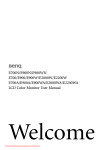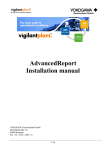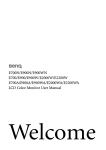Download DXA120 DAQSTANDARD DX-P Hardware Configurator User`s Manual
Transcript
User’s Manual DXA120 DAQSTANDARD DX-P Hardware Configurator IM 04L41B01-65EN 4th Edition User Registration Thank you for purchasing YOKOGAWA products. We invite you to register your products in order to receive the most up to date product information. To register, visit the following URL. http://www.yokogawa.com/ns/reg/ PRS 108-01E Thank you for purchasing the DAQSTANDARD (model name: DXA120). This manual explains how to use the software. Please read this manual carefully before operating the software to ensure its correct use. Notes • This software cannot connect to a DX100P/DX200P whose style number is S4 or earlier. • The contents of this manual are subject to change without prior notice. • Every effort has been made in the preparation of this manual to ensure accuracy. However, if any questions arise or errors are found in this manual, please inform the nearest Yokogawa sales representative office. • Copying or reproduction by any means of all or any part of the contents of this manual without permission is strictly prohibited. • Transfer or loan of the software to a third party is prohibited. • Once the software is unpacked, Yokogawa will not guarantee the designed operation of the software, except when the original floppy disk is found to be physically defective. • Yokogawa will not accept any responsibility for damage caused directly or indirectly as result of use of this software. • The serial number will not be reissued, therefore, it must be kept in a safe place. Copyright Yokogawa holds the copyright to the software that is on the CD-ROM. Trademarks • vigilantplant, DAQSTATION, Daqstation, DXAdvanced, and MVAdvanced are registered trademarks of Yokogawa Electric Corporation. • Microsoft and Windows are registered trademarks or trademarks of Microsoft Corporation in the United States and/or other countries. • Adobe and Acrobat are registered trademarks or trademarks of Adobe Systems Incorporated. • Company and product names that appear in this manual are registered trademarks or trademarks of their respective holders. • The company and product names used in this manual are not accompanied by the registered trademark or trademark symbols (® and ™). Revisions 1st Edition: 2nd Edition: 3rd Edition: 4th Edition: March 2010 June 2010 November 2010 January 2014 4th Edition: January 2014 (YK) All Right Reserved, Copyright © 2010, Yokogawa Electric Corporation IM 04L41B01-65EN i Terms and Conditions of the Software License NOTICE - PLEASE READ CAREFULLY BEFORE USE Thank you very much for purchasing this medium containing a software program and related documentation provided by Yokogawa Electric Corporation (hereinafter called “Yokogawa”), and the program contained, embedded, inserted or used in the medium (hereinafter called the “Yokogawa Software Program”). By installing the Yokogawa Software Program, you acknowledge that you understand and fully agree to the “Terms and Conditions of the Software License” (hereinafter called “Terms and Conditions”) which is written in the documentation and separately attached. Accordingly, the Terms and Conditions bind you. The Yokogawa Software Program and its related documentation including ownership of copyright shall remain the exclusive property of Yokogawa or those third parties who grants Yokogawa the rights. Yokogawa hereby grants you permission to use the Yokogawa Software Program on the conditions that you agree to the Terms and Conditions before you install it in or onto a computer. IF YOU DO NOT AGREE TO THE TERMS AND CONDITIONS, YOU CANNOT INSTALL THIS MEDIUM, AND MUST PROMPTLY RETURN IT TO YOKOGAWA OR ITS DESIGNATED PARTY. Terms and Conditions of the Software License Yokogawa Electric Corporation, a Japanese corporation (hereinafter called “Yokogawa”), grants permission to use this Yokogawa Software Program (hereinafter called the “Licensed Software”) to you on the conditions that you agrees to the terms and conditions stipulated in Article 1 hereof. You, as the Licensee (hereinafter called “Licensee”), shall agree to the following terms and conditions on the software license (hereinafter called the “Agreement”) when the Licensed Software is installed by the Licensee. Please note that Yokogawa grants the Licensee permission to use the Licensed Software under the terms and conditions herein and in no event shall Yokogawa intend to sell or transfer the Licensed Software to the Licensee. Article 1 (Licensed Software under these Terms and Conditions) 1.1 The terms and conditions stipulated herein shall bind any Licensee who purchases the Licensed Software on the condition that the Licensee consents to agree to the terms and conditions stipulated herein. 1.2 The “Licensed Software” and required number of license herein shall be specified in the following paragraphs (1) and (2) respectively. The Licensed Software means and includes all applicable programs and documentation, without limitation, all proprietary technology, algorithms, a factor, invariant, process and/or other know-how contained therein. These terms and conditions shall also govern any additional software to the Licensed Software inclusive of its version-up or revision-up if Yokogawa provides them to the Licensee. (1) Licensed Software Name: DAQSTANDARD (Model DXA120) (2) Number of License: 1 Article 2 (Grant of License) 2.1 Yokogawa grants the Licensee, for the purpose of single use, non-exclusive and non-transferable license of the Licensed Software with the license fee separately agreed upon by both parties. 2.2 The Licensee is, unless otherwise agreed upon in writing by Yokogawa, not entitled to change, sell, distribute, transfer, or sublicense the Licensed Software. 2.3 The Licensed Software shall not be copied in part or in whole except for keeping one (1) copy for back-up purpose. The Licensee shall secure or supervise the copy of the Licensed Software by the Licensee itself with great, strict, and due care. 2.4 The Licensed Software remains the exclusive property of Yokogawa and, if any, those of third parties from whom Yokogawa is sublicensed (hereinafter such third party’s software is called “Third Party Software”, which may include any software program made or coded by affiliates of Yokogawa). In no event shall the Licensee dump, reverse assemble, reverse compile, or reverse engineer the Licensed Software so that the Licensee may translate the Licensed Software into other programs or change it into a man-readable form from the source code of the Licensed Software. Unless otherwise separately agreed upon by Yokogawa, Yokogawa shall not provide the Licensee the source code for the Licensed Software. 2.5 The Licensed Software and its related documentation inclusive of its ownership of copyright shall be the proprietary property of Yokogawa or a third party who grants Yokogawa the rights. In no event shall the Licensee transfer, lease, sublicense, or assign any rights relating to the Licensed Software. 2.6 Yokogawa may use or add copy protection in or onto the Licensed Software. In no event shall, regardless of the purpose, the Licensee remove or attempt to remove such copy protection. 2.7 The Licensed Software may include the Third Party Software. In the case that Yokogawa is granted permission to sublicense to third parties by any licensors (sublicensor) of the Third Party Software under different terms and conditions than those stipulated in this Agreement, the Licensee shall observe such terms and conditions of which Yokogawa notifies the Licensee in writing separately. 2.8 In no event shall the Licensee modify, remove or delete a copyright notice of Yokogawa and its licenser contained in the Licensed Software, including any copy thereof. Article 3 (Restriction of Specific Use) 3.1 The Licensed Software shall not be intended specifically to be designed, developed, constructed, manufactured, distributed or maintained for the purpose of the following events: a) Operation of any aviation, vessel, or support of those operations from the ground; b) Operation of nuclear products, its facilities and/or radiation apparatus;, c) Operation of nuclear weapons, chemical weapons and/or biological weapons, or railroad; or d) Operation of medical instrumentation directly utilized for humankind or the human body. 3.2 Even if the Licensee uses the Licensed Software for the purposes in the preceding Paragraph 3.1, Yokogawa has no liability to or responsibility for any claims or damages arising out of the use or operations of the Licensed Software, and the Licensee agrees, on its own responsibility, to solve and settle the claims and damages and to defend, indemnify or hold Yokogawa totally harmless, from or against any liabilities, losses, damages and expenses (including fees for recalling the Products and reasonable attorney’s fees and court costs), or claims arising out of and related to the above-said claims and damages. Article 4 (Warranty) 4.1 The Licensee shall agree that the Licensed Software shall be provided to the Licensee on an “as is” basis when delivered. If defect(s), such as damage to the medium of the Licensed Software, attributable to Yokogawa is found, Yokogawa agrees to replace, free of charge, any Licensed Software on condition that the defective Licensed Software shall be returned to Yokogawa’s specified authorized service facility within 12 month from the delivery of Yokogawa after opening the Package at the Licensee’s expense. As the Licensed Software is provided to the Licensee on an “as is” basis when delivered, in no event shall Yokogawa warrant that any information on or in the Licensed Software, including without limitation, data on computer programs and program listings, be completely accurate, correct, reliable, or the most updated. 4.2 Notwithstanding the preceding Paragraph 4.1, when Third Party Software is included in the Licensed Software, the warranty period and related conditions that apply shall be those established by the provider of the third party software. ii IM 04L41B01-65EN Terms and Conditions of the Software License 4.3 When Yokogawa decides in its own judgement that it is necessary, Yokogawa may from time to time provide the Licensee with Release Upgrades specified by Yokogawa (hereinafter called “Release Upgrades”). 4.4 Notwithstanding the preceding Paragraph 4.3, in no event shall Yokogawa provide Updates where the Licensee or any third party conducted renovation or improvement of the Licensed Software. 4.5 Correction of nonconformity in the manner and for the period of time provided above shall be the Licensee’s sole and exclusive remedy for any failure of Yokogawa to comply with its obligations and shall constitute fulfillment of all liabilities of Yokogawa and any third party licensing the Third Party Software to Yokogawa (including any liability for direct, indirect, special, incidental or consequential damages) whether in warranty, contract, tort (including negligence but excluding willful conduct or gross negligence by Yokogawa) or otherwise with respect to or arising out of the use of the Licensed Software. 4.6 THE FOREGOING WARRANTIES ARE EXCLUSIVE AND IN LIEU OF ALL OTHER WARRANTIES OF QUALITY AND PERFORMANCE, WRITTEN, ORAL, OR IMPLIED, AND ALL OTHER WARRANTIES INCLUDING ANY IMPLIED WARRANTIES OF MERCHANTABILITY OR FITNESS FOR A PARTICULAR PURPOSE ARE HEREBY DISCLAIMED BY YOKOGAWA AND ALL THIRD PARTIES LICENSING THIRD PARTY SOFTWARE TO YOKOGAWA. Article 5 (Infringement) 5.1 If and when any third party should demand injunction, initiate a law suit, or demand compensation for damages against the Licensee under patent right (including utility model right, design patent, and trade mark), copyright, and any other rights relating to any of the Licensed Software, the Licensee shall promptly notify Yokogawa in writing to that effect. 5.2 In the case of the preceding Paragraph 5.1, the Licensee shall assign to Yokogawa all of the rights to defend the Licensee and to negotiate with the claiming party. Furthermore, the Licensee shall provide Yokogawa with necessary information or any other assistance for Yokogawa’s defense and negotiation. If and when such a claim should be attributable to Yokogawa, subject to the written notice to Yokogawa stated in the preceding Paragraph 5.1, Yokogawa shall defend the Licensee and negotiate with the claiming party at Yokogawa’s cost and expense and be responsible for the final settlement or judgment granted to the claiming party in the preceding Paragraph 5.1. 5.3 When any assertion or allegation of the infringement of the third party’s rights defined in Paragraph 5.1 is made, or when at Yokogawa’s judgment there is possibility of such assertion or allegation, Yokogawa will, at its own discretion, take any of the following countermeasures at Yokogawa’s cost and expense. a) To acquire the necessary right from a third party which has lawful ownership of the right so that the Licensee will be able to continue to use the Licensed Software; b) To replace the Licensed Software with an alternative one which avoids the infringement; or c) To remodel the Licensed Software so that the Licensed Software can avoid the infringement of such third party’s right. 5.4 If and when Yokogawa fails to take either of the countermeasures as set forth in the preceding subparagraphs of Paragraph 5.3, Yokogawa shall indemnify the Licensee only by paying back the price amount of the Licensed Software which Yokogawa has received from the Licensee. THE FOREGOING PARAGRAPHS STATE THE ENTIRE LIABILITY OF YOKOGAWA AND ANY THIRD PARTY LICENSING THIRD PARTY SOFTWARE TO YOKOGAWA WITH RESPECT TO INFRINGEMENT OF THE INTELLECTUAL PROPERTY RIGHTS INCLUDING BUT NOT LIMITED TO, PATENT AND COPYRIGHT. Article 6 (Liabilities) 6.1 If and when the Licensee should incur any damage relating to or arising out of the Licensed Software or service that Yokogawa has provided to the Licensee under the conditions herein due to a reason attributable to Yokogawa, Yokogawa shall take actions in accordance with this Agreement. However, in no event shall Yokogawa be liable or responsible for any special, incidental, consequential and/or indirect damage, whether in contract, warranty, tort, negligence, strict liability, or otherwise, including, without limitation, loss of operational profit or revenue, loss of use of the Licensed Software, or any associated products or equipment, cost of capital, loss or cost of interruption of the Licensee’s business, substitute equipment, facilities or services, downtime costs, delays, and loss of business information, or claims of customers of Licensee or other third parties for such or other damages. Even if Yokogawa is liable or responsible for the damages attributable to Yokogawa and to the extent of this Article 6, Yokogawa’s liability for the Licensee’s damage shall not exceed the price amount of the Licensed Software or service fee which Yokogawa has received. The Licensee agrees that Yokogawa shall be released or discharged from part or all of the liability under this Agreement if the Licensee modifies, remodels, combines with other software or products, or causes any deviation from the basic specifications or functional specifications, without Yokogawa’s prior written consent. 6.2 All causes of action against Yokogawa arising out of or relating to this Agreement or the performance or breach hereof shall expire unless Yokogawa is notified of the claim within one (1) year of its occurrence. 6.3 In no event, regardless of cause, shall Yokogawa assume responsibility for or be liable for penalties or penalty clauses in any contracts between the Licensee and its customers. Article 7 (Limit of Export) Unless otherwise agreed by Yokogawa, the Licensee shall not directly or indirectly export or transfer the Licensed Software to any countries other than those where Yokogawa permits export in advance. Article 8 (Term) This Agreement shall become effective on the date when the Licensee receives the Licensed Software and continues in effect unless or until terminated as provided herein, or the Licensee ceases using the Licensed Software by itself or with Yokogawa’s thirty (30) days prior written notice to the Licensee. When aforesaid termination or cease is occurred, the Licensee shall immediately destroy and/or eliminate the Licensed Software and related documents without retaining any copies or extracts thereof. However, upon specifically instructed by Yokogawa, they shall be returned to Yokogawa or its designated third party. Article 9 (Injunction for Use) During the term of this Agreement, Yokogawa may, at its own discretion, demand injunction against the Licensee in case that Yokogawa deems that the Licensed Software is used improperly or under severer environments other than those where Yokogawa has first approved, or any other condition which Yokogawa may not permit. Article 10 (Termination) Yokogawa, at its sole discretion, may terminate this Agreement without any notice or reminder to the Licensee if the Licensee violates or fails to perform this Agreement. However, Articles 5, 6, and 11 shall survive even after the termination. Article 11 (Jurisdiction) Any dispute, controversies, or differences between the parties hereto as to interpretation or execution of this Agreement shall be resolved amicably through negotiation between the parties upon the basis of mutual trust. Should the parties fail to agree within ninety (90) days after notice from one of the parties to the other, both parties hereby irrevocably submit to the exclusive jurisdiction of the Tokyo District Court (main office) in Japan for settlement of the dispute to the fullest extent allowed by applicable law. Article 12 (Governing Law) This Agreement shall be governed by and construed in accordance with the laws of Japan. The Licensee expressly agrees to waive absolutely and irrevocably and to the fullest extent permissible under applicable law any rights against the laws of Japan which may have pursuant to the Licensee’s local law. Article 13 (Severability) In the event that any provision hereof is declared or found to be illegal by any court or tribunal of competent jurisdiction, such provision shall be null and void with respect to the jurisdiction of that court or tribunal and all the remaining provisions hereof shall remain in full force and effect. IM 04L41B01-65EN iii How to Use This Manual Structure of the Manual This manual consists of the following five chapters and index. Chapter 1 2 3 4 Index Title Before using the DAQSTANDARD Viewing and Creating Setup Data Receiving and Sending Setup Data Troubleshooting Content Explains the PC system environment required for use of the DAQSTANDARD. Also explains how to install it. Explains how to view DX100P/DX200P setup data and how to create new setup data. Explains how to connect to a DX100P/DX200P through the Ethernet interface and how to send and receive setup data. Gives a list of error messages and corrective measures. Gives a list of important terms used in this manual. Range of Explanation in this Manual This manual does not explain the basic operations of your PC's operating system (OS). For such descriptions, refer to the Windows User’s Guide etc. Conventions Used in This Manual • Unit K..................... Indicates “1024”. (Example: 100 KB) • Menus, commands, dialog boxes and buttons Enclosed in [ ]. • Note Provides useful information regarding operation of the software. About Images The images that appear in this manual may be different from those that appear on the software, but not to a degree that interferes with procedural explanations. Products Covered in This Manual In this manual, the terms “DX100P” and “DX200P” refer to the following models. Terms DX100P DX200P Revision History Edition 1 2 3 4 iv Models DX100P DX102P, DX104P, DX106P, and DX112P with release number 4 and later DX200P DX204P, DX208P, DX210P, DX220P, and DX230P with release number 4 and later Additions and Changes New edition. Changes to the operating environment (support for Windows 7). Improvements to descriptions. Changes to the operating environment (Support for Windows XP SP2 is terminated). Changes to the operating environment (Support for Windows 2000 is terminated, and support for Windows 8). IM 04L41B01-65EN Contents 1 Terms and Conditions of the Software License................................................................................. ii How to Use This Manual................................................................................................................... iv Chapter 1 Before Using the DAQSTANDARD 1.1 Overview of the DAQSTANDARD........................................................................................ 1-1 About DX-P Hardware Configurator................................................................................ 1-1 How Data Is Managed..................................................................................................... 1-2 1.2 Required PC System Environment....................................................................................... 1-4 Chapter 2 Viewing and Creating Setup Data 2.1 Confirming the Setup Data................................................................................................... 2-1 2.2 Configuration........................................................................................................................ 2-5 2.3 Setting the Measurement Channels..................................................................................... 2-6 Input Type and Span....................................................................................................... 2-7 Difference Computation/Scaling/Square Root Computation........................................... 2-7 Alarm............................................................................................................................... 2-8 Input Filter and Moving Average..................................................................................... 2-8 Tag.................................................................................................................................. 2-8 Display Zone................................................................................................................... 2-8 Graph.............................................................................................................................. 2-9 Partial Expanded Display................................................................................................ 2-9 Display Color................................................................................................................... 2-9 Copying and Pasting Setup Data.................................................................................. 2-10 Setting One Channel at a Time..................................................................................... 2-10 2.4 Setting the Computation Channels (/M1 Option).................................................................2-11 2.5 Configuring the Engineering Mode..................................................................................... 2-14 Screen Display.............................................................................................................. 2-14 Message/File................................................................................................................. 2-15 Group/Trip Line............................................................................................................. 2-16 View Group (for the DX200P Only)............................................................................... 2-16 USER Key and Daylight Saving.................................................................................... 2-17 Batch............................................................................................................................. 2-18 Calibration Correction................................................................................................... 2-18 2.6 Configuring the System Mode............................................................................................ 2-19 Alarm/Relay/Remote..................................................................................................... 2-19 Scan Interval/Memory/Memory Timeup........................................................................ 2-20 Channel (Setting the Burnout and RJC)........................................................................ 2-21 Application..................................................................................................................... 2-22 Timer (/M1 Option)........................................................................................................ 2-22 Report (Creating Hourly/Daily/Weekly/Monthly Reports, Option)................................. 2-23 Temperature Unit, Time Zone, Time deviation limit, System Relay and Auxiliary Functions....................................................................................................................... 2-24 Active Storage Change................................................................................................. 2-25 Network......................................................................................................................... 2-26 Setting the Modbus Master........................................................................................... 2-29 Setting SNTP................................................................................................................ 2-32 2.7 Adjusting the Setup Data (Checking the Data)................................................................... 2-33 2.8 Saving the Setup Data........................................................................................................ 2-34 2.9 Printing the Setup Data....................................................................................................... 2-35 2.10 Characters That Can Be Used............................................................................................ 2-36 IM 04L41B01-65EN v 2 3 4 Index Contents Chapter 3 Receiving and Sending Setup Data 3.1 Connecting to the DXP......................................................................................................... 3-1 Notes about Sending and Receiving............................................................................... 3-1 Password........................................................................................................................ 3-1 3.2 Receiving Setup Data from the DXP.................................................................................... 3-2 3.3 Sending Setup Data to the DXP........................................................................................... 3-3 Chapter 4 Troubleshooting 4.1 Messages and Corrective Actions........................................................................................ 4-1 Error Messages............................................................................................................... 4-1 Warning Messages......................................................................................................... 4-2 Messages........................................................................................................................ 4-2 Index vi IM 04L41B01-65EN Chapter 1 Before Using the DAQSTANDARD 1.1 Overview of the DAQSTANDARD 1 2 3 Viewer Viewer displays the values and waveforms of the measured data from the recorder and prints them. Hardware Configurator Hardware Configurator is a software application for creating setup data for the recorder. It can send setup files that you have created to the recorder and save them to storage media. It can be used with the following recorders: the DX1000, DX1000N, DX2000, DX100, DX200, CX1000, CX2000, MV1000, MV2000, MV100, and MV200. DX-P Hardware Configurator DX100P/DX200P Hardware Configurator is a software application for creating setup data for the DX100P/DX200P recorder. It can send setup files that you have created to the recorder and save them to storage media. About DX-P Hardware Configurator Confirming the Setup Data You can use the Hardware Configurator to display and confirm the setup data. Creating Setup Data You can create new setup data by editing the opened setup data. However, the setup data of login information and batch system settings cannot be created. • Create new setup data. • You can also create setup data by changing the system configuration (number of measurement channels, options, etc.) of the opened setup data. • On the DX200P, you can assign screens to the [4 panel] display and set screen names. • Load the DX100P/DX200P (hereinafter “the DXP”) setup data via the communication interface. Transmit setup data to the DXP (function available on DXP style S4 or later). Setup data List ................ ................ ................ DXP (Style S4 or later) 1 2 3 4 5 6 11 16 21 26 7 12 17 22 27 8 13 18 23 28 9 14 19 24 29 10 15 20 25 30 DISP/ ENTER Transmit setup data Communication via the Ethernet Receive setup data Display the data CH01 CH02 CH03 CH04 VOLT TC RTD VOLT OFF OFF OFF ON CH01 CH02 CH03 CH04 TC TC TC TC ON ON ON ON Save To the DXP Create setup data CH01 CH02 CH03 CH04 VOLT VOLT VOLT VOLT OFF OFF OFF ON Save Setup data: Setup data of the DXP (.ppl extension). IM 04L41B01-65EN Before Using the DAQSTANDARD The DAQSTANDARD consists of the following three utility programs. • Launcher • Hardware Configurator • DX100P/DX200P Hardware Configurator This manual explains Viewer. 1-1 4 Index 1.1 Overview of the DAQSTANDARD Connection (Login) Conditions DXP (Style S4 or later) 1 2 3 4 5 6 11 16 21 26 7 12 17 22 27 8 13 18 23 28 9 14 19 24 29 10 15 20 25 30 DISP/ ENTER User name User ID Password Administrator Setup data Send setup data Receive setup data CH01 CH02 CH03 CH04 TC TC TC TC ON ON ON ON Change password • Only the administrators that are registered to the target DXP can log in. The administrator is confirmed using the user name, user ID, and password. • Connection is not possible if there is a user logged in using the keys on the DXP or if there is a user logged into the setting function of the setting/measurement server via the communication interface (see IM04L05A01-17E). • Connection is not possible using a user name that is already connected. Transmitting and Receiving Setup Data You can load DXP setup data. You cannot view the login information and batch/system settings. You can send setup data to the DXP. The contents of [Login information], [Batch system settings], and [IP Address] are not transmitted. How Data Is Managed The setup data is assigned a “configuration serial number” in the order of occurrence. This number is recorded in the batch data/continuous data as a part of the operation log of setting changes. Includes setup data saved using keys on the DXP, setup data saved using the DX-P Hardware Configurator, and setup data received using the Communication Function. The configuration serial number is “0.” Setup data used during data acquisition (The data is saved within the batch data/continuous data file.) Operation log ************* ***********2 ************* 1 No configuration serial number 2 3 Configuration serial number Setup data when the settings are changed 0 Configuration serial number Other setup data 1-2 IM 04L41B01-65EN 1.1 Overview of the DAQSTANDARD Viewing the Contents of the Login Information and Batch System Settings Setup data in the engineering mode Administrator User name User ID Password Setup data in the system mode* 2 3 Login information Batch system settings * Setup data in the system mode excluding the login information and batch system settings • Login information: Contents of the registered administrators and users • Batch system settings: Contents of the login function and the electronic signature function 4 Index User Locked A user is invalidated if a wrong password is entered three consecutive times at the password prompt. An invalidated user cannot apply electronic signature to the data. In addition, the user cannot view the contents of the login information and batch system settings of the relevant batch data and continuous data. IM 04L41B01-65EN 1 Before Using the DAQSTANDARD Only the administrator that was registered at the time the data was acquired can view the contents of the login information and batch system settings of the data. The administrator is confirmed using the user name, user ID, and password. 1-3 1.2 Hardware Required PC System Environment Personal Computer A computer which runs on Windows XP, Windows Vista, Windows 7, or Windows 8. CPU and Main Memory • When Using Windows XP Pentium III, 600 MHz or faster Intel x64 or x86 processor; 128 MB or more of memory • When Using Windows Vista Pentium 4, 3 GHz or faster Intel x64 or x86 processor; 2 GB or more of memory • When Using Windows 7 or Windows 8 32-bit edition: Intel Pentium 4, 3 GHz or faster x64 or x86 processor; 2 GB or more of memory 64-bit edition: Intel x64 processor that is equivalent to Intel Pentium 4, 3 GHz or faster; 2 GB or more of memory Hard Disk A free space of 100 MB or more (more space may be required, depending on the amount of data stored). CD-ROM Drive To be used for installing the software. Mouse A mouse supported by Windows. Monitor A video card that is recommended for the OS and a display that is supported by the OS, has a resolution of 1024×768 or higher, and that can show 65,536 colors (16-bit, high color) or more. Interface Port An RS-232 port or an Ethernet port supported by the OS. Printer A printer supported by Windows is required. An appropriate printer driver is also required. Operating System (OS) OS Windows XP Windows Vista Windows 7 Windows 8 Version Home Edition SP3 Professional SP3 (excluding x64 Editions) Home Premium SP1, SP2 (excluding 64-bit editions) Business SP1, SP2 (excluding 64-bit editions) Home Premium 32-bit and 64-bit editions Professional 32-bit and 64-bit editions 32-bit and 64-bit editions (Supports the desktop mode) Pro 32-bit and 64-bit editions (Supports the desktop mode) Note • The time zone can be set in [Date/Time] which can be opened from [Control Panel]. • If daylight saving time is used, mark the check box of “Automatically adjust clock for daylight saving changes”. • The time zone should not be set using the autoexec.bat file. If “TZ=GTM0” is set in the file, specify “rem” to disable it. • Data created in 2038 or later cannot be handled. • The font “Courier New” needs to be installed on your personal computer. 1-4 IM 04L41B01-65EN Chapter 2 2.1 Viewing and Creating Setup Data Confirming the Setup Data 1 Starting the DX-P Hardware Configurator Prints (section 2.9) Loads Setup Data Sends Setup Data Data check (section 2.7) Displays the version information This tab appears when you operate to display the login information . Menu bar Tool bar Scroll the screen (left and right) Note You cannot change the contents of the imported setup file and overwrite the file. Exiting the DX-P Hardware Configurator Select [File] - [Exit] or click [x]. The Hardware Configurator ends. If you changed the settings in any of the windows (see section 2.2), operate as follows: 1. Select [File] - [Exit] or click [x]. A message “Save changes to ***?” is displayed. 2. Click [Yes], if you wish to save the new settings and exit the Hardware Configurator. The [Save as] dialog box opens (see section 2.8). Proceed to step 3. Click [No], if you wish to exit the Hardware Configurator without saving the settings. The Hardware Configurator ends. 3. Set the directory and the file name. Click [Save]. IM04L41B01-65EN 3 4 Index Scroll the screen (up and down) 2 Viewing and Creating Setup Data From the Start menu, select [Programs] - [DAQSTANDARD] - [DX-P Hardware Configurator]. You can also start DX-P Hardware Configurator from Viewer. The login information and the batch system settings (in the system mode tab) can be displayed when you operate properly. The Hardware Configurator ends. 2-1 2.1 Confirming the Setup Data Confirming the Setup Data Click this tab to open “Meas” Click this tab to open “Math” Click this tab to open “Settings” Click this tab to open “System Mode” Click this tab to open “Login Information” For the detail of the login information and the batch system settings, see next page. For the description of other settings, see sections 2.3 to 2.6. Confirming the Data Information 1. Select [Information] - [Data Information...]. 2. The [Information] dialog box opens. 3. To close the dialog box, click [OK]. Confirming the System Configuration 1. Select [System] [System Configuration]. 2. The [System Configuration] dialog box opens. 3. To close the dialog box, click [OK]. 2-2 IM04L41B01-65EN 2.1 Confirming the Setup Data Confirming the Login Information and the Batch System Settings 1 Confirming the Login Information 2 To confirm the information other than login information and batch system settings, see section 2.2 and the following sections. 3 When the time set expires, the password change is required. Range of operations permitted (see below). Administrator: All operations User: The number shows the range of operations Click this tab to display the login information. 4 Index Menu bar Tool bar Scroll the screen. Users Free: Operation permitted Lock: Operation prohibited [Other] includes the following operations. • Displaying the log • Displaying the file list of the external storage medium. • Performing an FTP test • Displaying the Modbus status screen • Assigning names to 4 screens (DX200P only). Login Mode The settings of [Sign record] and [Key] to [Other] are called [Login Mode]. IM04L41B01-65EN Viewing and Creating Setup Data Administrators Names of invalidated users are diaplayed in red. 2-3 2.1 Confirming the Setup Data Confirming Batch System Settings 2. Click here (also selectable from [Setting] - [System Mode Setting]) 1. Select this tab. Batch system settings Login function Electronic signature function • Login user ID You are requested to enter the user ID when logging in. • Auto logout If there is no key operation for the specified time, the user is automatically logged out. If [OFF] is selected, the user is logged out only when the logout operation is performed. • Display change without Login If [ON] is specified, the operation screen can be switched without logging in. • Use sign record function Use the electronic signature function. • Sign record at Batch stop Sign record display is automatically displayed when data acquisition is stopped. However, this is invalid if a single batch data is divided into multiple files. • Sign record user ID You are requested to enter the user ID when applying electronic signature. 2-4 IM04L41B01-65EN 2.2 Configuration 1 This operation is for creating new setup data (excluding the login information and batch system settings). Viewing and Creating Setup Data Starting Editing 2 This operation enables editing setup data. 1. Select [Edit] [Edit Configuration]. 3 2. The [Edit Data] dialog box opens. 4 Index 3. Click [OK] to start editing Note When you start editing, the login information and batch system settings are not displayed. To initialize the setup data without changing the system configuration, proceed to “Initializing the Setup Data.” To change the system configuration, proceed to “Changing the System Configuration.” Initializing the Setup Data This operation is for initializing the setup data without changing the system configuration. 1. Select [Setting] - [Initialize]. 3. Click [OK] to execute the initialization. 2. The [initialize] dialog box opens. Changing the System Configuration 1. Select [System] - [System Configuration]. 2. The [System Configuration] dialog box opens. 3. Configure the system. 4. Click here. 5. The [System configuration] dialog box opens. 6. Click here. The setup data is initialized. IM04L41B01-65EN 2-5 2.3 Setting the Measurement Channels Select this tab Double-click to set the channel Select the input mode Difference computation Scaling Square root Select the range/type Select the reference for the difference computation Set the span Initialize Set the selected range at once Turn OFF at once Copy the settings of the first channel in the selected range to all other channels Selecting a Range of Channels You can select a range of channels by dragging the mouse from a channel to another channel in the CH column. Click [CH] to reset the selected range. Enter the scale Enter the scale unit Select the alarm type Enter the alarm value Select the relay number Set the value to the maximum value possible Set the value to the minimum value possible Enter the delay period Enter the tag name Select sampling count for the moving average or time constant of the input filter. Enter the display zone Select the graph setting Turn ON/OFF the partial expanded display 2-6 Select the channel display color IM04L41B01-65EN 2.3 Setting the Measurement Channels 1 Input Type and Span Mode, Range/Type Select from the list of choices from the pull-down menu. Mode VOLT TC RTD DI SKIP Range/Type 20 mV, 60 m V, 200 mV, 2 V, 6 V, 20 V, 50 V TypeR, S, B, E, K, J, T, N, W, L, U Pt100, JPt100, Cu10*, Cu25* LEVEL (voltage level), CONT (Contact) None * /N1 option 2 3 Note If SKIP is selected, settings such as Delta/Scale/Sqrt and Range/Type are discarded. 4 Span L, Span U Sets the upper and lower limits (full scale) of the display. When a value outside the range is entered or when the span L and span U values are set to the same value, they are corrected when the data are checked. Measured value Span U (100% on display) Input value Values within the measurable range Span L (0% on display) Difference Computation/Scaling/Square Root Computation DELTA: Displays the difference between the input and the reference channel. Note Difference computation is performed between channels that have different [Mode] and [Range/Type] settings. The decimal position of the computed result is set to that of the channel computing the difference. If the number of digits to the right of the decimal of the reference channel is greater than that of the channel computing the difference, the reference value below the least significant digit of the channel computing difference is rounded beforehand. SCALE: Converts the input value to a value in the appropriate unit. SQRT: Computes the square root of the input. The result is converted to a value in the appropriate unit. This setting can be used only when the input mod is set to VOLT. DELTA SCALE Measured value Span U Input value + Span L Scale U Scale conversion Input value – Measured value Span U Span L Decimal position Unit Scale L Measured value on the reference channel SQRT Measured value Span U Scale U Scale conversion Input value Span L Decimal position Unit Scale L Span L, Span U Sets the appropriate upper and lower limits (see figures above). When a value outside the range is entered or when the span L and span U values are set to the same value, they are corrected when the data are checked. IM04L41B01-65EN Viewing and Creating Setup Data Input Type DC Voltage Thermocouple Resistance temperature detector ON/OFF input Measurement/Display OFF 2-7 Index 2.3 Setting the Measurement Channels Scale L, Scale U, and Decimal Point Enter the upper and lower limit values to which you wish to convert the input values. Set the decimal position by the number of digits to the right of the decimal point. When the scale L and scale U values are set to the same value or when a value outside the range is entered, they are corrected when the data are checked. Unit Clicking the unit display area enables entering a new unit. Enter the unit using up to six characters. Alarm Four alarms (Alarm 1 to 4) can be specified on each channel. Type Select from [H], [L], [h], [l], [R], [r], [T] or [t]. [h] and [l] can be specified on difference computation channels only. Select [OFF] to disable alarm. Alarm Value Alarm is generated using the specified value as the boundary. The selectable range of alarm values vary depending on the input mode and range. Alarm Delay This applies to delay upper (T) and lower (t) limit alarms. Alarm is generated when the measured value stays above or below the specified alarm value for the specified time (delay period). Relay To output relays, select the output relay number. Otherwise, select [NONE]. Input Filter and Moving Average Moving average can be specified on models DX106P, DX112P, DX210P, DX220P, and DX230P. Input filter can be specified on models DX102P, DX104P, DX204P, and DX208P. Input Filter To use the input filter, select the time constant (2 s, 5 s, or 10 s). Moving Average To use the moving average, select the sampling count (2 to 16). Tag Display Zone 2-8 Up to 16 characters can be entered for the tag. You can use the tag name instead of the channel number to be displayed on the screen. The [System Mode] screen is used to select whether to display the channel number or the tag name on the screen. You can select the range of the screen in which the waveform of each channel is to be displayed. Specify positions (%) on the display scale for the upper and lower limits. The conditions for setting the zones are as follows: • Range: 0% to 100% The lower limit must be less than the upper limit • The difference between the lower and upper limits is at least 5%. IM04L41B01-65EN 2.3 Setting the Measurement Channels Graph 1 Divisions Select the number of scale divisions. 2 Bar Graph Viewing and Creating Setup Data Select the reference position of the bar graph. Selecting [Center] when the bar graph is vertical produces no effect. It is set back to [Normal] when the data are checked. 3 Scale When using scale display on the trend screen, select the position to display the scale. For details related to divisions, bar graph, and scale, see section 5.12 in the DX100P/ DX200P User’s Manual. 4 Partial Expanded Display ON/OFF Set whether or not to use the partial expanded display for each channel. Index Note The partial expansion settings take effect when the partial expansion function is set to [Use] in the [Aux] section of the [System Mode] tab. Position (%) Set the position to which the boundary value is to be moved. The range is from 1 to 99%. Boundary Set the boundary value within the display span. The conditions used to set the boundary vary depending on the measurement and computation channels as follows: • Measurement channel When SCALE and SQRT are not used: Span L < boundary < span U When SCALE and SQRT are used: Scale L < boundary < scale U • Computation channel Span L < boundary < span U Display Color You can select the display color of each channel from 16 colors. Clicking the color area displays the [Color] dialog box. Select a color and click [OK]. IM04L41B01-65EN 2-9 2.3 Setting the Measurement Channels Copying and Pasting Setup Data The items checked in [Copy Details] can be copied and pasted. Click the channel number to select the copy source or paste destination. To select multiple channels to be copied, drag the channel number to specify the range to be copied. To select multiple copy destinations, select the range in a similar fashion. 2. The [Meas. Channel Copy Details] dialog box opens. 1. Click here. 6. Click here. 5. Select the copy source. 3. Select copy items. 4. Click here. 8. Click here. 7. Select the paste destination. Setting One Channel at a Time The items in the [Meas] tab can be configured for each channel. The items that are configured are the same as those configured on the spreadsheet. For details, see pages 2-6 to 2-9. 3. Select the tab of the item to be configured. 1. Double-click the channel you wish to set. 2. The channel setting dialog box opens. 4. After setting the items, click here. Apply the settings. Update according to the changes in the [Meas] sheet. 2-10 IM04L41B01-65EN 2.4 1 Set the display span. Enter the unit (6 characters or less). Enter the constant to be used in the expression. 2 Double-click when setting each channel. Turn ON/OFF computation. Select this tab. Enter the expression Viewing and Creating Setup Data Setting the Computation Channels (/M1 Option) 3 4 Select the number of digits to the right the decimal. Set the alarm (section 2.3). Index Tools (section 2.3) Alarm delay time Enter the tag (section 2.3). Waveform display zone (section 2.3) Graphic settings (section 2.3) Partial expanded display (section 2.3) Display color (section 2.3) Turning ON/OFF Computation Select whether or not to perform computation for each channel. Expression Constant IM04L41B01-65EN Enter the expression using up to 40 characters. For details related to the expression, see the DX100P/DX200P User’s Manual. You can set constants to be used in the expression. Up to 12 (DX100P) or 30 (DX200P) constants can be specified. The allowed range is as follows: –9.9999E+29 to –1.0000E–30, 0, 1.0000E–30 to 9.9999E+29 2-11 2.4 Setting the Computation Channels (/M1 Option) Display Span Alarm Tag Sets the upper and lower limits of the display. The range is from –9999999 to 99999999. Set the number of digits to the right the decimal to four digits or less. You can set up to 4 alarms on each computation channel. The alarm types are upper limit alarm (H), lower limit alarm (L), delay upper limit alarm (T), and delay lower limit alarm (t). For details, see section 2.3. The settings are the same as the measurement channels. For details, see section 2.3. TLOG Computation Timer Select one of the timers (1 to 3) set in the setup mode. The computation interval of TLOG computation is set to the time assigned to the selected timer. Sum Scale Set the sum scale. Rolling Average Interval Select the sampling interval when rolling average is activated. Times (Number of Samples) Select the number of samples (number of data points used to compute the rolling average). Display Zone, Graph, Partial Expansion, and Color The settings are the same as the measurement channels. For details, see section 2.3. Copying and Pasting Setup Data The items checked in [Copy Details] can be copied and pasted. See the operating procedure, see section 2.3. 2-12 IM04L41B01-65EN 2.4 Setting the Computation Channels (/M1 Option) Setting One Computation Channel at a Time The items in the [Math] tab can be configured for each channel. The items that are configured are the same as those configured on the spreadsheet. For details, see pages 2-11 and 2-12. 3 4 1. Double-click the channel you wish to set. 2. The channel setting dialog box opens. Index 4. After setting the items, click here. Set the maximum value. Set the minimum value. Copy the first setting. Select the operator type. Select the operator. IM04L41B01-65EN 2 Viewing and Creating Setup Data 3. Select the tab of the item to be configured. Click here to enter the operator The [Select Operator] dialog box opens. 1 2-13 2.5 Configuring the Engineering Mode Screen Display Select this tab. Select the time per division Select the display direction of the trend and bar graphs. Set the screen background color to white or black. Line width 1 to 3 dots On: Use Off: Not use The backlight saver function is activated, when there is no key operation or alarm occurrence for the “Saver time.” Recovers by a key operation or alarm occurrence. Recovers by a key operation. Display Update Interval You can select the display update interval from [1 min/div], [2 min/div], [5 min/div], [10 min/div], [15 min/div*], [20 min/div], [30 min/div], [1 h/div], [2 h/div], [4 h/div], and [10 h/div]. In addition to these selections, [15 sec/div] and [30 sec/div] can also be selected on the DX102P, DX104P, DX204P and DX208P. * A [15 min/div] is for the DXP style S4 or later only. Auto Save Interval You can set the interval, if the data type is set to [DISPLAY] in the memory sample settings of the system mode tab. However, if the type of process is set to [Batch] in the application settings of the system mode tab, the maximum selectable time is automatically entered and cannot be selected. Grid Division Select number of grids on the waveform display area from [Auto] or [4] to [12]. Auto: Display the same number of grids as the number of scale divisions of the first assigned channel of the group. Auto Scroll Time This is the time period used to automatically switch the displayed group. Select the time period from [5 s], [10 s], [20 s], [30 s], or [1 min]. LCD Brightness Select the brightness of the screen from [1] to [8] (DX100P), or [1] to [4] (DX200P). A higher value corresponds to a brighter screen setting. 2-14 IM04L41B01-65EN 2.5 Confiuring the Engineering Mode Message/File Click here (also selectable from [Setting] [Engineering Mode Setting]). Select the group. Enter the group name. Enter the message. Copy and paste the message. 1 2 Viewing and Creating Setup Data 3 4 Index Enter the comment. Enter the save destination folder. Resets the range selection. Message number Note Messages 1 to 8 of the message group 7 can be assigned to the USER key and the remote control function (option, /R1). Group Name Up to 16 characters can be entered for the message. Message Up to 32 characters can be entered for the message. File Header Adds a comment (up to 32 characters) to the header section of the measured/computed data file. Directory Name Set the name of the folder (up to 8 characters) in which the measured/computed data files is to be saved. Note • AUX, CON, PRN, NUL, and CLOCK cannot be used as the directory name. • If the directory name is not specified, DATA0 (default) is automatically set. Copying and Pasting the message 1. Click the message number of the copy source. To select multiple messages to be copied, drag the message number to specify the range to be copied. 2. Click [Copy]. 3. Click the message number of the paste destination. To select multiple paste destinations, select the range in a similar fashion. 4. Click [Paste]. IM04L41B01-65EN 2-15 2.5 Confiuring the Engineering Mode Group/Trip Line Click here (also selectable from [Setting] - [Engineering Mode Setting]). Select the tab of the group to be configured. Enter the group name. Turn ON/OFF the trip line display. Check the channels that you wish to register to the selected group (blue: ON). Set the trip line by dragging. Set the trip line by entering a value. Select the color of the trip line. Group Name Up to 16 characters can be entered for the group name. Number of Channels The maximum number of channels that can be assigned to a group is 6 for the DX100P and 10 for the DX200P. The assigned channels are listed under [Channel Configuration]. Trip Line Up to four trip lines can be set to one group. With regard to the trip lines set here, the first and second settings (No.1 and No. 2) refer to the trip lines in the Data Viewer. If you change them here, they will also change in the Data Viewer. View Group (for the DX200P Only) View Group Up to four view groups can be registered. Group Name Up to 16 characters can be entered for the group name. The specified group name appears as a sub menu of the [4 Panel] display of the DX200P. Screen Type The view group is made up of four screens. Select the type of screen to display in each screen. Group to Be Displayed Select the group to be displayed from group 1 to group 6 when the screen type is set to trend, digital, or bar graph. 2-16 IM04L41B01-65EN 2.5 Confiuring the Engineering Mode Click here (also selectable from [Setting] - [Engineering Mode Setting]) Enter the view group name. Select the type of screen from the menu or drag & drop the screen. 1 2 Viewing and Creating Setup Data 3 4 Index Select the group. Types of screens available USER Key and Daylight Saving Click here (also selectable from [Setting] - [Engineering Mode Setting]). Select the function to be assigned to the USER key. DST start time DST end time User Key Assign an action to the USER key. The [Message1] to [Message8] correspond to messages 1 to 8 of the message group 7. Select [NONE] to disable the USER key. Daylight Saving Select whether or not to use the daylight savings time adjustment function. Specify the start and end time of the DST. IM04L41B01-65EN 2-17 2.5 Confiuring the Engineering Mode Batch Click here (also selectable from [Setting] - [Engineering Mode Setting]). Automatically increase the lot number by 1 at Memory Stop. Use the lot number indication. Header 1 to 3 Enter character strings (up to 64 characters) that are written to the batch and continuous data files. Calibration Correction Can only be specified on measurement channels. Click here (also selectable from [Setting] - [Engineering Mode Setting]). Select channel. Select the number of set points. Enter values. Number of Set Points Set point number Select the number of set points from [OFF] or [2] to [16]. Select [OFF] if you are not using the correction function. Selectable Range of Measured and True Values Channels that are set to scaling or square root computation: –30000 to 30000 (the decimal point position depends on the channel setting) All other channels: Selectable range in the specified range For the measured value, set a value that is greater than the previous measured value. If you enter a setting that does not meet these conditions, the [Number of Set Points] is set to [OFF] when you store the setup data, print the setup data, or send the setup data to the DXP using the Communicator. 2-18 IM04L41B01-65EN 2.6 Configuring the System Mode 1 Alarm/Relay/Remote 2 Viewing and Creating Setup Data 2. Click here (also selectable from [Setting] - [System Mode Setting]). 1. Select this tab. 3 4 Remote control terminal number Resets the range selection. Copy and paste the selected range (see page 4-15). Select actions. Alarm/Relay • Reflash When multiple alarms are set to one alarm output relay, this function notifies the succeeding alarms after the first alarm that causes the relay activation. • Relay AND Set the range of relays (from the first alarm relay) to take the AND logic. All other relays will be set to OR logic. If [NONE] is selected, all relays will operate using the OR logic. • AND: Activated when all alarms are being generated simultaneously. • OR: Activated when at least one of the alarms is being generated. • Relay Action Select whether to energize or de-energize the alarm output relay when the alarm occurs. • Alarm Relay Behavior • Unhold: Turns OFF the output relay when the cause of the alarm is no longer met. • Hold: Holds the output relay ON until the alarm acknowledge operation is executed. • Alarm Indicator Unhold, Hold: See “Alarm Relay Behavior.” When [Alarm Relay Behavior] is set to [Hold], only [Hold] can be selected for the [Alarm Indicator]. • Rate of Change Increase/Rate of Change Decrease Select the time interval for the rate of change alarms in terms of the number of samplings (1 to 15). Interval = scan interval × number of samplings • Alarm Hysteresis A width (hysteresis) of 0.5% of the display span can be specified on the value used to set or release the alarm. This applies to upper (H) and lower (L) limit alarms on measurement channels. IM04L41B01-65EN 2-19 Index 2.6 Configuring the System Mode Remote (Option, /R1) You can assign items to be controlled by the eight remote control terminals. This is possible, if the remote function is available. Scan Interval/Memory/Memory Timeup Click here (also selectable from [Setting] - [System Mode Setting]). Check the channels you wish to sample. Resets the range selection. Select the range. Turn ON/OFF at once. Set these parameters when the data type is set to [EVENT & DISP] or [EVENT]. A/D Integrate 100 ms can be selected only when the scan interval is set to [2 s]. Auto: The DXP will automatically switch between [60 Hz] or [50 Hz]. Scan Interval The selectable scan intervals vary depending on the model as follows: DX102P, DX104P, DX204P, DX208P: 125 ms and 250 DX106P, DX112P, DX210P, DX220P, DX230P: 1 s and 2 s Memory Sample (Save Method of Measured/Computed Data) • Data When the data type is [EVENT], set [Event Data Sampling Rate] and [Data Length]. The selectable data length vary depending on the sampling rate. However, if the type of process is set to [Batch] in the application settings of the system mode tab (see page 2-22), the maximum selectable time is automatically entered and cannot be selected. • Sampling Select the channels whose data is to be saved to the memory. To collectively select or deselect a specified range, carry out the following procedure. 1. Specify the range by dragging the mouse over the desired range on the column (if you do not carry out this step, all channels are specified). You can reset the range by pressing the Initialize button. 2. The selected/deselected condition of the specified range of channels switch each time the ON/OFF at once button is clicked. 2-20 IM04L41B01-65EN 2.6 Configuring the System Mode 1 Memory Timeup Specify the date and time to save the data in the internal memory to the external storage medium. • Timeup type 2 • Date Date (1 to 28) or the day of the week (SUN, MON, TUE, WED, THU, FRI, and SAT) • Time (Hour) Hours (00 to 23) Channel (Setting the Burnout and RJC) Click here (also selectable from [Setting] - [System Mode Setting]). Set to the positive side (100%). Set to the negative side (0%). Set the reference junction compensation to internal or external. Copy and paste (see page 4-15). Tools (see page 4-6) Channel number Select the range by dragging & dropping the mouse. Resets the range selection. Burnout For thermocouple (TC) inputs, select how the measurement results are to be handled when the thermocouple burns out. RJC Volt (uV) Internal: Use the DXP’s reference junction compensation function External: Use an external reference junction compensation function. Volt(uV): When the type is set to [External], set the compensation value in the range from –20000 to 20000. Copying and Pasting Setup Data The items checked in [Copy Details] can be copied and pasted. For the operating procedure, see page 2-5. IM04L41B01-65EN 2-21 Viewing and Creating Setup Data Time interval to save the data. Set [OFF] to disable the function. Hour: 1 hour, Day: 1 day, Week: 1 week, Month: 1 month 3 4 Index 2.6 Configuring the System Mode Application Click here (also selectable from [Setting] - [System Mode Setting]). Check here if you wish to clear the waveform display and start data acquisition. Select the type of process. Application Batch: You can sign the batch data in batch units. Continue: You can sign the continuous data in units of file Timer (/M1 Option) Click here (also selectable from [Setting] - [System Mode Setting]). Select one. Select whether or not use [Save Data]. Select whether or not use [Reset]. You can set three types of timers. You can have the data saved to a TLOG file or reset the TLOG computation when the specified timeout time elapses. Timer Mode There are two timer modes: absolute mode and relative mode. Select [OFF] to disable the timer. • Absolute Mode Timer expires at times determined from the reference time and the interval. Interval: Select from [1 min], [2 min], [3 min], [4 min], [5 min], [6 min], [10 min], [12 min], [15 min], [20 min], [30 min], [1 h], [2 h], [3 h], [4 h], [6 h], [8 h], [12 h], and [24 h]. The reference time is specified by the hour (00 to 23). Ref. time: Select from 0 to 23 hours. • Relative Mode The timer is started when the computation is started. The timer is repeated at each interval. Interval: 1 min to 24 hours 2-22 IM04L41B01-65EN 2.6 Configuring the System Mode 1 Reset Reset the results of TLOG computation when the timer expires. Save Data Report (Creating Hourly/Daily/Weekly/Monthly Reports, Option) 2 Viewing and Creating Setup Data Measured/computed data of all channels can be saved to the external storage medium at intervals specified by a timer (TLOG data). 3 Click here (also selectable from [Setting] - [System Mode Setting]). Set the date and time at which to create the report. 4 Index Tools (see page 4-6) Select the channel to be reported. Enable (ON) / Disable (OFF) the report channel settings. Report channel No. Select the range by dragging the mouse. Resets the range selection. Report Type Select the type of report to be created. Select [OFF] to create no report. Report Time Date (1 to 28) and time (0 to 23) for monthly report, time (0 to 23) for daily report, the day of the week (SUN to SAT) and time (0 to 23) for weekly report. Report Channel There are 12 (DX100P) and 30 (DX200P) report channels. To collectively select or deselect a specified range, carry out the following procedure. Specify the range by dragging the mouse over the desired range on the column (if you do not carry out this step, all report channels are specified). You can reset the range by pressing the reset button. Converting the Reference Unit Time Select whether or not to convert the computed results of the TLOG.SUM computation channels to a specified time unit value. Off: Carry out a simple summation. Sec: Convert a measured value to a value per second and carry out the summation. Min: Convert a measured value to a value per minute and carry out the summation. Hour: Convert a measured value to a value per hour and carry out the summation. Day: Convert a measured value to a value per day and carry out the summation. Copy/Paste The items checked in [Copy Details] can be copied and pasted. For details related to the copy and paste function, see page 2-10. IM04L41B01-65EN 2-23 2.6 Configuring the System Mode Temperature Unit, Time Zone, Time deviation limit, System Relay and Auxiliary Functions Click here (also selectable from [Setting] - [System Mode Setting]). Temperature Unit Select the °C or °F for the temperature unit. GMT (Time Zone) Set the time difference from the GMT. Time deviation limit If the time deviation between the specified time and the time on the DXP is within ± (the value specified here) when data acquisition is in progress, the time on the DXP is gradually corrected. Select [OFF], [10s], [20s], [30s], [1min], [2min], [3min], [4min], or [5min]. If [Off] is selected, the time cannot be adjusted when data acquisition is in progress. System Relay Assign functions to the system relays 1 and 2. FAIL: De-energized when failure occurs. MEMORY END: Energized when the remaining write time of the internal memory is less than or equal to the specified time, or when the free space of the external storage medium is less than or equal to 10% or 6 MB. BATCH START/STOP: Energized at Memory Start, de-energized at Memory Stop. USER LOCKED: The relay is energized when user lock occurs. LOGIN: The relay is energized when there is a user logged into the DXP*. * Login using keys and login to the setting function via the Ethernet or serial interface. Aux • Tag/Channel Select whether to use the tag name or channel number as the measurement/ computation channel label. • Memory Alarm Time When the remaining time for storing the display or event data in the internal memory falls to the specified time (Memory alarm time), an alarm is generated via e-mail or the relay contact output (/F1 option). Memory Alarm: 1 h, 2 h, 5 h, 10 h, 20 h, 50 h, or 100 h OFF: Do not use the memory end function. 2-24 IM04L41B01-65EN 2.6 Configuring the System Mode 1 • Displayed Language Select the language to be used on the display. • Partial Expanded Display If the partial expanded display is set to [Not], the partial expanded display settings of the Meas/Math tab are void. Viewing and Creating Setup Data • Remote Controller ID (/KB1, /KB2 option) 2 Select the remote controller ID from [0] to [31]. Select [Off] if you do not use the remote control terminal. 3 • Media FIFO Select [ON] when using the storage area of the storage medium cyclically (FIFO). 4 Active Storage Change Click here (also selectable from [Setting] - [System Mode Setting]). Index Turn [ON] the setting changes that are allowed when data acquisition is in progress. Time change The time can be changed. User change Users can be registered or the registration information can be corrected. Cal. correct change (/CC1 option) The calibration correction setting can be changed. Text message on cal correct (/CC1 option) Selectable when [Cal. correct change] is set to [ON]. If the calibration correction setting is changed when acquisition is in progress, a message “Cal Correct Setting” is written. IM04L41B01-65EN 2-25 2.6 Configuring the System Mode Network The “Memory Data Out” setting is void on the DX100P/DX200P. Setting the TCP/IP 1. Click here (also selectable from [Setting] - [System Mode Setting]) 2. Select this tab Set the IP address Set these addresses when using the DNS DNS setting Enter the timeout value when turned ON You must set the DNS, if you are using a host name to specify the destination server of the file transfer on an FTP client or the server of the e-mail recipient. Host Name, Domain Name, Domain Suffix: Up to 64 characters Keep Alive This function forcibly drops the connection if there are no responses to the test packets that are sent periodically (every 30 seconds) at the TCP level. Timeout This function drops the connection if no data transfer is detected between the PC and the DXP over a predetermined period of time. This applies to data transfer at the application level only. To use this function, select [ON] and enter a time period (1 to 120 min). Communication Input Available User Specify a user that uses the communication input data (DX100P: C01 to C12, DX200P: C01 to C30) from [Admin 1] to[ User 30], and [Serial] (/C2 or /C3 option). Serial: The communication input data can be used via the serial communication. Memory Data Out Select [Ethernet]. 2-26 IM04L41B01-65EN 2.6 Configuring the System Mode 1 FTP Connection Specify the primary and secondary file transfer destinations (FTP servers). 2. Select the primary or secondary tab. 1. Select this tab. 2 Viewing and Creating Setup Data 3 Select the file transfer destination 4 Index • Server Name Set the FTP server name using up to 64 alphanumeric characters. You can also specify the IP address. In this case, DNS is not necessary. • Port Number Set the port number of the destination FTP server in the range from 1 to 65535. The default setting is [21]. • Login Name, Password, Account Set the login name (up to 32 characters), the password (up to 32 characters), and the account (the ID number, up to 32 characters) to use when accessing the FTP server. • PASV When using the DXP behind a firewall that requires the PASV mode, turn this mode [On]. • Initial Path Set the destination directory for the file transfer using up to 64 alphanumeric characters. Example: /home/data • Disp & Event Data Display data files and event data files are automatically transferred to the specified destination at specified intervals. • Report A Report file is automatically transferred to the specified destination when it is created. • Snapshot A screen image data file is automatically transferred to the specified destination when a snapshot is executed. IM04L41B01-65EN 2-27 2.6 Configuring the System Mode Setting the Serial Communication • Data Length Select the data length from the following list. Make sure to select 8 bits when outputting data in binary format. • RS232 Handshaking Select the handshaking method from the following list. This setting is valid only for the RS-232 interface. • RS-422A/485 Address Select the address from 1 to 32. This setting is valid for the RS-422A/485 interface and the Modbus protocol. • RS-422A/485 Protocol 2-28 OFF: Serial communication is disabled. NORMAL: Setting/measurement server MODBUS: Modbus slave MODBUS MASTER: Modbus master BARCODE: Bar code input IM04L41B01-65EN 2.6 Configuring the System Mode Setting the Modbus Master 1 Set the command. 2 Viewing and Creating Setup Data 3 4 Index Data type Register No. (slave device) Address (slave device) Communication input data (DX100P: C01 to C12, DX200P: C01 to C30) Select whether or not use command. • Basic Read cycle: The cycle at which data is read from other devices. Select the read cycle from [125 ms], [250 ms], [500 ms], [1 s], [5 s], [2 s], or [10 s] Timeout: Specify a time period that the DXP waits for a response from the specified slave device after transmitting a command. Select the timeout time from [125 ms], [250 ms], [500 ms], [1 s], [5 s], [2 s], [10 s], or [1 min]. Retrials: The number of times to retransmit the command when there is no response from the specified slave device. Select the number of retrials from [Off] (0), [1], [2], [3], [4], [5], [10] or [20]. • Type • INT16: 16-bit signed integer • UINT16: 16-bit unsigned integer • INT32_B: “32-bit signed integer” is assigned to the Modbus register in the order upper 16 bits followed by the lower 16 bits. • INT32_L: “32-bit signed integer” is assigned to the Modbus register in the order lower 16 bits followed by the upper 16 bits. • UINT32_B: “32-bit unsigned integer” is assigned to the Modbus register in the order upper 16 bits followed by the lower 16 bits. • UINT32_L: “32-bit unsigned integer” is assigned to the Modbus register in the order lower 16 bits followed by the upper 16 bits. • FLOAT_B: “32-bit floating-point data” is assigned to the Modbus register in the order upper 16 bits followed by the lower 16 bits. • FLOAT_L: “32-bit floating-point data” is assigned to the Modbus register in the order lower 16 bits followed by the upper 16 bits. IM04L41B01-65EN 2-29 2.6 Configuring the System Mode Setting the Web Server Operator page Monitor page Select whether or not use the Web server. Select whether or not use Monitor/Operator page. • Access control/User name/Password Select whether or not use the access control. To use the access control, enter the user name (up to 20 characters) and password (up to 8 characters) to display the operator or monitor page. 2-30 IM04L41B01-65EN 2.6 Configuring the System Mode 1 Setting the E-Mail Transmission Transmit e-mail when alarm occurred/released. Transmit e-mail at specified time. Transmit e-mail when storage medium error, etc. are detected. Transmit e-mail when creating a report. 2 Viewing and Creating Setup Data 3 4 Select the recipient Select the alarm Transmit e-mail when creating a report. Attach measured/computed data at that time 0 • SMTP server name Set the SMTP server name (up to 64 alphanumeric characters) or the IP address of the SMTP server. • Port number Set the port number to use in the range from 1 to 65535. The default value is [25]. • Recipient Set the transmission destination of the e-mail message using up to 150 alphanumeric characters. You can specify multiple addresses. To specify multiple addresses, delimit the addresses using spaces. • Sender Set the e-mail address using up to 64 alphanumeric characters. If the address is not set, the first address set in the recipient box is used as the sender’s address instead. • Alarm Transmits an e-mail message when alarm is active/released. • Scheduled Transmits an e-mail message when the specified time is reached. • System Transmits an e-mail message during recovery from a power failure, when memory end is detected, or when an error related to the external storage medium and FTP client occurs • Report Transmits an e-mail message when report is created (only on models with the optional computation function (/M1) • Subject, Header1, Header2 Subject: Set the subject of the e-mail message using up to 32 alphanumeric characters. Header1 and Header2: Set the string to be attached to the e-mail message using up t 64 alphanumeric characters. IM04L41B01-65EN 2-31 Index 2.6 Configuring the System Mode Setting SNTP SNTP server function SNTP client function • Basic • SNTP server Select [ON] when using the SNTP server function. The DXP sends time information to SNTP clients on the network. • SNTP client Select [ON] when using the SNTP client function. The DXP queries time information to an SNTP server on the network. • Server name Set the access destination of time information using up to 64 alphanumeric characters. Set the server host name or IP address. • Port Number Set the port number of the SNTP server in the range from 1 to 65535. The default value is [123]. • Access interval Select the time interval for querying the time on the SNTP server from [Off], [1h], [8h], [12h], or [24h]. Time is not queried if [Off] is selected. • Access reference time The time used as a reference for the time query. The time is queried at the specified access interval with respect to this time. Set the time in the range of 00:00 to 23:59. • Access timeout The timeout period for a response from the SNTP server. If no response is received within this time period, time query will not be performed. Select [10s], [30s], or [90s]. • SNTP synched to start (Time adjust on Start action) Set whether to query the time using the SNTP client function (ON/OFF) when data acquisition is started. 2-32 IM04L41B01-65EN 2.7 Adjusting the Setup Data (Checking the Data) Checking the Setup Data 2 1. Click here ([System] - [Data Adjustment]). 3 or 2. If the data are not consistent, the [Data Adjustment] dialog box opens (see the description below). 4 Click here to display the correction list The data are corrected in the following cases: • When the values of the items of the Meas/Math tab are outside the range. • When an invalid character string is used • When a set point value in the calibration correction setting is wrong. [Data Adjustment] Dialog Box Select [View] - [Data Adjustment Dialog] to use the [Data Adjustment] dialog box. If [View] - [Data Adjustment Dialog Box] is checked, the [Data Adjustment] dialog box will open when the data are not consistent at the time of the data check or at the time of data transmission. IM04L41B01-65EN Viewing and Creating Setup Data 2. If the data are not consistent, they are automatically corrected. 1 2-33 Index 2.8 Saving the Setup Data Saving the Setup Data Saves the setup data b specifying the save destination and file name. 1. Select [File] - [Save As]. 2. The [Save As] dialog box opens. 3. Set the destination and file name and click here Note • You cannot save the data using the same file name as the file in the save destination (overwriting the file is not allowed). • You cannot edit the setup data after saving it. If you wish to change the settings further, start from “Starting Editing” in section 2.2. 2-34 IM04L41B01-65EN 2.9 Printing the Setup Data 1 Setting the Printer 2 1. Select [File] - [Print Setup]. Viewing and Creating Setup Data 3 4 Index 2. Set the printer, paper and orientation. Note Set the printer according to the environment of the system that you are using. Print Preview You can preview the print layout before actually printing the data. Selecting [File] - [Print Preview] displays the print preview screen. Printing 1. Click here ([File] - [Print]). 2. The [Selection of print contents] dialog box opens. (Only when the login information is displayed) 3. Select the print contents and click here. 4. The [ Print] dialog box opens. 5. Select the printer, print range, the number of copies, and click [OK]. IM04L41B01-65EN 2-35 2.10 Characters That Can Be Used The characters in the following table can be used when entering a group name, a view group name, a message, a comment to the file header, a save destination directory name, and parameters such a the user name, user ID, and password for signing. SP 0 A K U a k u # 1 B L V b l v _ % 2 C M W c m w ( ) 3 D N X d n x 4 E O Y e o y * 5 F P Z f p z + 6 G Q 7 H R . 8 I S / 9 J T g q h r i s j t @ Note (*), (+), (.), and (/) cannot be used for the name of the directory where files are to be saved. 2-36 IM04L41B01-65EN Chapter 3 Receiving and Sending Setup Data 3.1 Connecting to the DXP 1 Notes about Sending and Receiving 2 Note Password 4 Index Note Default password For the following cases, enter the default password in the Password box. • Connecting for the first time after user registration. • Connecting for the first time after resetting the password because the user was invalidated. User Administrator 1 to 3 User 01 to 30 Default Password Admin1, Admin2, and Admin3 User01, User02, User03, ... , User29, and User30 User Locked The user who is invalidated through the key operation on the DXP cannot log in from the DDX-P Hardware Configurator. When the password is expired Enter the password. For a description of the password, see “Note” below. Click here. Note New password • Enter the password using 6 to 8 characters. • Spaces are not allowed. • Combinations of the user ID and password that have been used in the past are not allowed. IM 04L41B01-65EN 3 Receiving and Sending Setup Data • The Communicator Software can connect to the DXP style number S4 or later. • Only the administrators that are registered to the target DXP can connect to it. • Connection is not possible if there is a user logged in using the keys on the DXP or if there is a user connected to the setting function via the communication interface. • Connection is not possible if a user with the same user name is already connected via the communication interface (the setting/measurement server, the monitor function of the maintenance/test server, or the FTP server). • If the DXP is configured not to use the login function (no administrators are registered), you can connect to the DXP by entering the IP address or host name in the IP address box. • The Manager is locked while connected to the DXP. 3-1 3.2 Receiving Setup Data from the DXP 1. Select [Comm.] - [Receive Setting]. 3. The [Receiving data] dialog box opens. 2. If the setup data has been edited, a save confirmation message appears. (If the data has not been edited, the Receiving data dialog box opens.) For information about saving setup data, see section 2.8. 4. Enter the IP address, user name, user ID, and password. 5. Click here. • If the password has expired, see page 3-1. Start reception after you change the password. 6. A progress indicator appears. • If the data cannot be received, an error message appears. 7. The message “Receiving finished” appears and the received setup data is displayed. Note • You can edit the setup data that you receive. • The login information and batch/system settings are not displayed. • For a description of creating a new setup data based on the loaded setup data, see section 2.2. 3-2 IM 04L41B01-65EN 3.3 Sending Setup Data to the DXP 1 1. Select [Comm.] - [Send Setting]. 2 3 2. The [Sending data] dialog box appears. Receiving and Sending Setup Data 4 Index 3. Enter the IP address, user name, user ID, and password. 4. Click here. • If the password has expired, see page 3-1. Start sending after you change the password. 5. A progress indicator appears. • If the data cannot be sent, an error message appears. 6. The message “Sending finished” appears and the received setup data is displayed. Note • The function for sending the setup data to the DXP cannot be used while the DXP is acquiring data or performing computation. • The contents of [Login information], [Batch system settings], and [IP Address] are not transmitted. • In the following cases, errors occur and the data cannot be sent to the DXP. • When an external storage medium is not inserted in the DXP. • When the setup data to be sent does not match the system configuration of the DXP. • If an error occurs while data is being sent, an error message is displayed, and the DXP returns to the main screen that appears during sending. Start the procedure for sending the data over again. The data sent before the error is not applied on the DXP. IM 04L41B01-65EN 3-3 Chapter 4 4.1 Troubleshooting Messages and Corrective Actions 1 Messages may appear on the screen during operation. This section explains the meanings of the error messages and how to respond to them. 2 Error Messages Code E7001 E7002 Message Unreadable file Failed to open file. E7003 E7004 Failed to make file. A user is already logged in. Unable to login now. E7006 E7007 E7008 Password is incorrect. No system administrator’s privilege. The number of connection has been exceeded. E7009 Communication Error E7010 E7011 E7012 The device’s style number is earlier than S4. Can’t receive setting. This password is not effective or was already used. Now sampling. Can’t store settings. E7013 E7014 Now calculating. Can’t store settings. Now sampling & calculating. Can’t store settings. E7015 DXP System configurations are different. E7016 E7017 E7018 E7019 E7020 E7021 E7022 E7023 Operation aborted because an error was found on media. Not enough free space on media. Media is read-only. Media has not been inserted. Media is damaged or not formatted. An error occurred during send procedure. An error occurred during receive procedure This user name is not registered. E7024 3times password input failure. E7025 3times password input failure. The user will be disable. The connected device is not supported! Failed to start Adobe Reader. E7026 E0250 IM 04L41B01-65EN 3 4 Troubleshooting E7005 Corrective Action/Explanation Select another file. Try to open the file again. If still not possible, the file may be damaged. Select another file. Check the free space in the directory. This may happen for one of the following reasons. Check the login conditions. • Another user with the same user name is already logged into the setting/measurement server, maintenance/test server, or FTP server. • Another user is already logged into the setting function of the setting/measurement server. • Another user has logged in to the DXP through key operations. • Another user who has logged in to the DXP through serial communication commands. This may happen for one of the following reasons: • The user name is invalid. • The user name, user ID, or password is not correct. • The specified user cannot log in through communication commands. Check to make sure that the password is correct. Log in as a system administrator. The maximum number of connections has been exceeded. Close other connections before connecting. • Check the LAN connection. • Make sure that the IP address and host name settings of the PC and the DXP that you are connecting to match. Use a DXP whose style number is S4 or later. Index Re-enter a different password. Send the data after the DXP finishes writing to the internal memory. Send the data after computation finishes. Send the data after the DXP finishes writing to the internal memory and computation finishes. Make sure that the setup information and the DXP system configuration match. Check the storage medium. Change the storage medium. Enable writing to the medium. Insert a storage medium. Change the storage medium or format it. Send again. Attempt to receive the data again. Make sure that you entered the correct user name, user ID, and password. Select Login information in the Information menu, and enter the system administrator information. A different system administrator must log in. The connected device is not a DX100P or DX200P. Make sure that the user’s manual exists and that Adobe Acrobat is installed. 4-1 4.1 Messages and Corrective Actions Warning Messages Code W7051 Message Save changes to NewFile? W7052 W7053 File already exist. System configuration has been changed. The input configuration and data will be initialized. Continue? Initialize current settings. Edit this configuration? W7054 W7055 Corrective Action/Explanation The setup information has been changed, but the file has not been saved. Choose whether or not to save the file. Specify a different file name. Choose whether or not to change the system configuration. Choose whether or not to initialize the current setup data. Choose whether or not to edit the data. Messages Code M7071 M7072 M7073 M7074 4-2 Message Data can’t be processed after the year 2038. Any destroyed A/D converter exists. Any settings may be failed to store. Receiving finished Sending finished IM 04L41B01-65EN Index Index 1 A H A/D integrate......................................................................... 2-20 active storage change........................................................... 2-25 alarm............................................................................. 2-8, 2-19 alarm delay.............................................................................. 2-8 alarm indicator....................................................................... 2-19 alarm value.............................................................................. 2-8 application............................................................................. 2-22 auto logout............................................................................... 2-4 auto scroll time...................................................................... 2-14 hardware (system requirements)............................................. 1-4 hourly reports........................................................................ 2-23 B M bar graph................................................................................. 2-9 batch...................................................................................... 2-18 batch system settings.............................................................. 2-3 boundary................................................................................. 2-9 media FIFO........................................................................... 2-25 memory sample..................................................................... 2-20 memory timeup...................................................................... 2-21 message................................................................................ 2-15 Modbus master, setting......................................................... 2-29 mode....................................................................................... 2-7 monthly reports...................................................................... 2-23 moving average....................................................................... 2-8 cal. correct change................................................................ 2-25 calibration correction............................................................. 2-18 channel (setting the burnout and RJC).................................. 2-21 channel, setting one at a time............................................... 2-10 characters that can be used.................................................. 2-36 computation, turning on and off..............................................2-11 computation channel, setting one at a time........................... 2-13 conventions................................................................................ iv copying.................................................................................. 2-10 D daily reports........................................................................... 2-23 DAQSTANDARD, software components................................. 1-1 DAQSTANDARD overview...................................................... 1-1 data, management.................................................................. 1-2 data information, confirmation................................................. 2-2 decimal point........................................................................... 2-8 delta......................................................................................... 2-7 display change without login................................................... 2-4 display color............................................................................ 2-9 displayed language............................................................... 2-25 divisions................................................................................... 2-9 DX-P Hardware Configurator................................................... 1-1 DX-P Hardware Configurator, starting..................................... 2-1 DXP, connection...................................................................... 3-1 E e-mail transmission, setting................................................... 2-31 editing, starting........................................................................ 2-5 engineering mode.................................................................. 2-14 expression..............................................................................2-11 F file.......................................................................................... 2-15 file header.............................................................................. 2-15 FTP connection..................................................................... 2-27 G GMT....................................................................................... 2-24 graph....................................................................................... 2-9 group..................................................................................... 2-16 group name........................................................................... 2-16 IM 04L41B01-65EN interval................................................................................... 2-12 3 L login information...................................................................... 2-3 N network.................................................................................. 2-26 O operating system..................................................................... 1-4 P partial expanded display................................................ 2-9, 2-25 password................................................................................. 3-1 pasting................................................................................... 2-10 position (%)............................................................................. 2-9 printing................................................................................... 2-35 print preview.......................................................................... 2-35 products covered in this manual................................................. iv R range....................................................................................... 2-7 reference unit time, converting.............................................. 2-23 relay............................................................................... 2-8, 2-19 relay AND.............................................................................. 2-19 remote................................................................................... 2-19 remote controller ID............................................................... 2-25 report channel....................................................................... 2-23 reports................................................................................... 2-23 revision history........................................................................... iv RJC........................................................................................ 2-21 S scale........................................................................................ 2-8 scan interval.......................................................................... 2-20 screen type............................................................................ 2-16 serial communication, setting................................................ 2-28 setup data, confirming............................................................. 2-2 setup data, reception............................................................... 3-2 setup data, transmission................................................. 1-2, 3-3 SNTP, setting......................................................................... 2-32 software license........................................................................... ii span......................................................................................... 2-7 sum scale.............................................................................. 2-12 Index-1 4 Index Index C I 2 Index system configuration............................................................... 2-2 system relay.......................................................................... 2-24 T text message on cal correct.................................................. 2-25 times...................................................................................... 2-12 time zone............................................................................... 2-24 TLOG..................................................................................... 2-12 trademarks...................................................................................i type.......................................................................................... 2-8 U user change........................................................................... 2-25 USER key.............................................................................. 2-17 user locked.............................................................................. 1-3 V view group............................................................................. 2-16 W Web server, setting................................................................ 2-30 weekly reports....................................................................... 2-23 Index-2 IM 04L41B01-65EN

























































